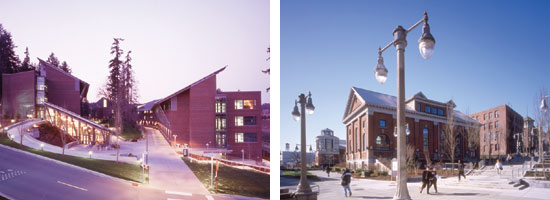

Washington’s graduation numbers may not be much better than this national study, but that doesn’t mean two-plus-two isn’t working. According to the state Higher Education Coordinating Board, about 40 percent of all students who graduate with a B.A. from public colleges and universities earned at least some of their credits at a community college.
Because of the inefficiencies, some states have evolved away from a two-plus-two model. University of Michigan branches in Flint and Dearborn started as upper-division campuses. Now both are four-year institutions. President Emmert used to teach at the University of Colorado at Denver, which also started as an upper-division branch of the main campus in Boulder but is now a four-year school with 12,000 students and more than 80 degree programs.
Emmert and the chancellors at both UWB and UWT disagree with the notion that the two-plus-two system should be replaced. “The two-plus-two model has some great advantages but it also has its limitations,” Emmert says. “We don’t want to throw the baby out with the bathwater. What we want to do is add more options, not eliminate opportunities.”
Emmert made this point when he and the chancellors reported to the higher education board in December. They embraced two-plus-two, calling for dramatic expansion in the number of openings they have for transfer students from community colleges. UW Tacoma wants to add more than 4,000 new seats for transfers by 2014. UW Bothell is asking for 3,900 more seats by 2020 just for transfers. And the Seattle campus will continue to reserve 30 percent of all new enrollments for transfers.

But all of these studies—two for UW and two for WSU—also called for a change in missions. The plans asked for new legislation to let these campuses offer some classes for freshmen and sophomores as well. The beginnings are modest—100 new freshmen for UWT and 90 for UWB by 2007—but the implications are dramatic. Community college officials, the news media and lawmakers have all zeroed in on the idea that these four regional campuses could now evolve into four-year universities.
The aim is not to siphon off community college students, say UW officials, but to attract students who want a four-year college experience in one setting. The Seattle campus turns away more than 3,000 resident students each year who would be qualified to attend if there were enough room. “Many of those who are turned away go to college out of state,” says UWT Interim Chancellor Steven Olswang, ’77. “A lot of them never come back.”
Both UWT and UWB want to offer a place where freshmen and sophomores take most of their classes together. They want to establish a cohesive learning community.
“If you look at the numbers, there is a need for lower-division classes that do not compete with community colleges,” says UWB’s Buck.
“The four-year model will benefit transfer students who are doing two-plus-two as well,” adds Olswang. If a business student in Tacoma decides to focus on the Asian economy, that student has to travel to a community college to take an introductory course in Asian history or an Asian language. By offering lower-division courses, transfer students can complete their B.A.s in one setting, rather than bouncing back and forth.
Both chancellors emphasize that they are not abandoning the two-plus-two model, but rather strengthening it. Their plans call for rapid expansion for transfers: The ratio of transfers to freshmen in the UWT plan is 8 to 1; in the UWB plan it is 13 to 1.
 In addition, the plans call for a more seamless transition for two-plus-two students. One proposal is a joint application with local community colleges that would accept two-plus-two students to a specific UW campus at the same time they become freshmen at their lower-division school.
In addition, the plans call for a more seamless transition for two-plus-two students. One proposal is a joint application with local community colleges that would accept two-plus-two students to a specific UW campus at the same time they become freshmen at their lower-division school.
Despite the assurances from UW and WSU that there are plenty of students to go around, community colleges are wary. While Cascadia’s president endorsed the UWB plan, one Tacoma educator was hesitant about UWT’s proposal. “Given how limited state resources are right now, we need to use our scarce dollars as prudently as possible,” says Tacoma Community College President Pamela Transue, ’73.
Transue was a member of the committee that wrote the plan for UW Tacoma. Her expertise in the state higher education system goes back to the birth of UWT and UWB, when she worked on the Seattle campus as a special assistant to UW President William P. Gerberding. “I was very much in the middle of the birth of the branches,” she recalls.
She says she fully supports the UWT recommendations but thinks the time is not right for offering freshman and sophomore classes. “The bottleneck is at the baccalaureate-level. Our transfer students need upper-division classes. The priority in Tacoma should be developing additional baccalaureate capacity and graduate capacity before expanding to the lower-division level,” she says.
Go To: Page 1 | Page 2 | Page 3